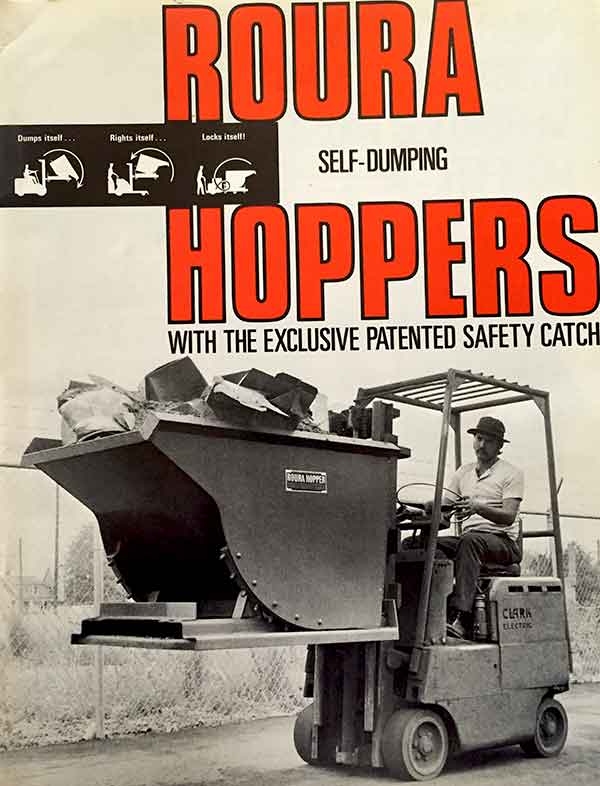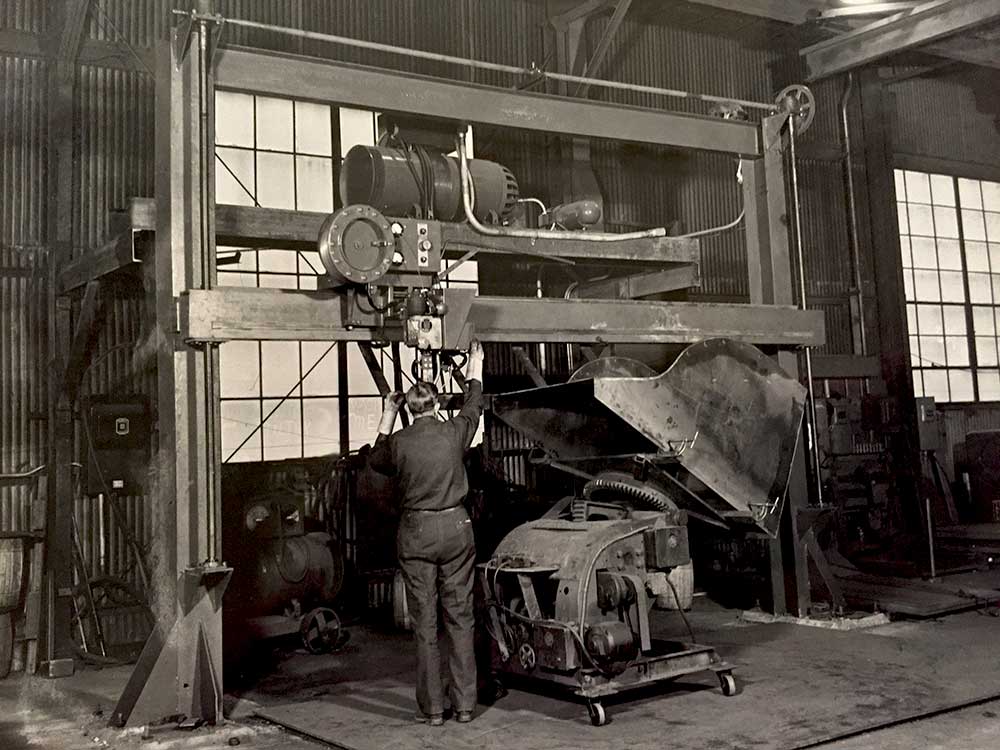
A self dumping hopper is a large sturdy container that allows an operator to dump its contents without coming in direct contact with them.
Each hopper features a body and a super-strong base, both forged from durable high-quality steel. Hoppers are equipped with handle release systems, but many models also offer a wide range of customizable options:
- Temporary and permanent covers
- Caster and wheel sets
- Base-to-body chains
- Drains and plugs
- Base legs
- Crane eyes
- Slide bolt latches
Our hoppers are coated in a standard safety green enamel finish, but you can also choose from safety red, blue, orange and yellow as well as brown, white, gray and black.
How Does a Dump Hopper Work?
The hopper’s safe and efficient design consists of the hopper body connected to its base by a sophisticated lever assembly and secured in an upright position. You use one of our three handle release systems to engage the lever assembly, rotating the hopper body forward while perfectly balanced. After the hopper releases its contents, the container returns to its upright resting position and locks back into place.
Who Uses Dump Hoppers?
Dump hoppers have transformed many industries’ material handling processes. Clients enjoy safer, less expensive and more convenient transport, storage and disposal. You’ll find our hoppers used in glassmaking, construction, milling, woodworking, food production, mining solid waste management, and agricultural environments. Many types of manufacturers also use our dumpers, along with foundries and stamping plants. This is just a short list, but it should give you an idea of how extensively they’re used.
How Are Dumping Hoppers Made?
Dumping hoppers are manufactured with a continuous weld construction using 12 and 10 gauge carbon steel. We use thicker hot rolled steel than most manufacturers: For instance, we choose ¼-inch thick steel when others incorporate 3/16-inch steel. As a result, our hoppers are stronger and heavier than the industry standard.
We also employ a hand-welded “innershield” process to produce an immensely hot weld for improved weld penetration and strength. Depending on the model, we also boost the hopper’s integrity by adding hidden corner supports under top support angles in critical weld areas.
How Do You Dump a Self Dumping Hopper?

You typically operate a dumping hopper while seated on a forklift, but customizable features allow the hopper to dump while it’s on the ground. We offer three types of handle releases on our dump hoppers: our Mechanical Hopper Release system, pull-down handles, and auto-latch handles.
We innovated the Mechanical Hopper Release system to let a forklift operator dump its contents while still sitting behind the wheel. Once the hopper is seated on the forks, the operator leaves the forklift and loosens the lock bolt, releasing and setting the adjustable pulley rail to a safe operating position.
After tightening the lock bolt to secure the pulley rail, the operator attaches the retractable pull handle to the forklift’s overhead guard frame. The forklift transports the hopper to its destination, then releases its contents using the pull handle.
Pull-down handles are designed for dumping from elevated heights while the hopper is carried on a forklift. A sturdy built-in cable system with a pull handle is installed on the rear of the hopper. The operator drives the forklift to the dumping point, then gets out of the vehicle to pull the handle and dump the hopper from a safe distance.
Meanwhile, our auto-latch handle secures the hopper in place until an operator pulls the handle. Once the contents are dumped and the hopper returns to the resting position, the handle lock engages.
Our MHR, pull-down and auto-latch systems are available in both left- and right-handed versions to accommodate your operators. Watch our short demonstration videos for more detailed instructions and to see these handle release systems in action. You can also check out our additional tips on safe operation and maintenance.
When Were Dump Hoppers Invented?
Joseph Roura established Roura Material Handling in 1915, but we designed and created our first dumping hoppers during the late 1920s. Before then, our primary purpose was fabricating and erecting steel for buildings, railroad bridges and landmarks in and around Detroit. The first hoppers supplemented our structural steel line of business, but it was that expertise in structural steel that helped the company develop a superior product.
Roura discontinued the structural steel business during the 1940s, focusing on manufacturing dump hoppers for defense purposes during World War II. Our hoppers became more popular with the growth of manufacturing in the United States. Since then, we’ve produced a huge selection of hoppers for clients all over the country. To keep pace with the demand, we opened our second facility in 1975. We now have two locations: Clinton Township, Michigan, and Holly Springs, Mississippi.
Common Types of Dump Hoppers
Roura produces six varieties of dump hoppers: durable, rugged, ultimate, behemoth, plastic lid and custom products. These product classes are designed to handle different content weights, volume capacities and materials types:
- Durable hoppers offer load capacities between 2,000 and 4,000 pounds. They’re best for lighter weight materials such as sawdust, glass or ash. Volumes range between 1/8 to 5 cubic yards.
- Rugged hoppers are ideal for coal, metal scrap, rubber and construction materials. They’re capable of loads ranging between 4,000 and 8,000 pounds, with volumes between 1/8 to 5 cubic yards.
- Ultimate hoppers are made for heavy-duty transport, with weight capacities between 8,000 and 10,000 pounds. They’re best suited for dense and heavy materials like demolition debris, brick and castings. Volumes range from 1/3 to 5 cubic yards.
- Behemoth hoppers are also perfect for heavyweight materials, but they come in large volume capacities. Like the ultimate models, load capacities range from 8,000 to 10,000 pounds. Choose from 6 to 10 cubic yard volumes to handle shipyard debris, hot ash, concrete, castings and other large hazardous materials.
- Plastic lid hoppers perform best when handling raw organic materials or food waste. The airtight lid manages odors and protects the contents from pests, wild animals, moisture and contamination. They’re available in load capacities of 4,000 and 6,000 pounds and volumes ranging from ½ to 2 ½ cubic yards.
Besides these varieties, we also offer custom hoppers to meet your specific material handling requirements. Our engineers and fabrication specialists can design a hopper according to the size, capacity and features you require. Contact us to discuss your needs.
Dump Hopper Basic Guide
Now that you’ve learned more about dump hoppers, you know why they’re the best time- and cost-saving tools for your operations. Whether you desire a pre-fabricated or custom hopper, we’re ready to make your material handling solutions come to life. To learn more or speak to us about your specific needs, contact us today.